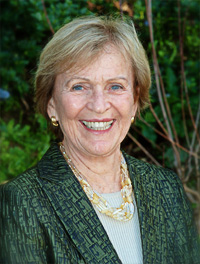 Margaret “Peggy” Lumpkin Keon is the benefactor of the Women in Public Service Project at Berea College. She is the former President of Keon Associates — a career consultation service, former board member of the College of Marin Foundation, and former Overseer for Wellesley Centers for Women at Wellesley College. She was also a founding board member of the Global AIDS Interfaith Alliance (GAIA).
Margaret “Peggy” Lumpkin Keon is the benefactor of the Women in Public Service Project at Berea College. She is the former President of Keon Associates — a career consultation service, former board member of the College of Marin Foundation, and former Overseer for Wellesley Centers for Women at Wellesley College. She was also a founding board member of the Global AIDS Interfaith Alliance (GAIA).
A long-standing theme with Peggy is the empowerment of women. Her father never let her work in the family business because she was a woman. In spite of the male bias in the family, Peggy forged her career in financial management and philanthropy. She founded the Margaret Lumpkin Keon Endowment for International Understanding at the Wellesley Centers for Women. The Endowment provides support for work that advances international understanding on issues of particular importance to women, with the central goal of fostering and advancing women’s human rights and well-being throughout the world.
Peggy is the author of I Remember Mollie, a biography of her mother. Her family’s roots are entwined in Berea’s own history. Peggy’s maternal great grandfather, William Hart Jr., was treasurer of Berea College from 1870 to 1880; a member of the BC Prudential Committee from 1870 to 1873, and a member of the Berea College Board of Trustee from 1873 until his death in 1887. His wife Susan was a Berea College matron.
Now in her early-80’s, Peggy continues a rigorous life of international travel. In 2011, she walked a 100 mile portion of the Camino de Santiago in northern Spain, a route walked by Christian pilgrims since the 9th century. In her words, “I would wish to be with a person or persons who really wanted to contemplate the meaning of the Camino, to think about the many people who have walked there over centuries of time.” She writes regularly about her international travels. Her journal about a recent trip to Nepal follows.
Nepal (2013) — Journal of Margaret Lumpkin Keon
When I mentioned to my traveling English friend Helen Bate, who resides nearby in the south of France, that I had the idea of going to Nepal to visit Olga Murray and see the Nepalese Youth Foundation’s projects there, she was immediately ready to go. Plans were quickly made, and we set off March 15 from Nice.
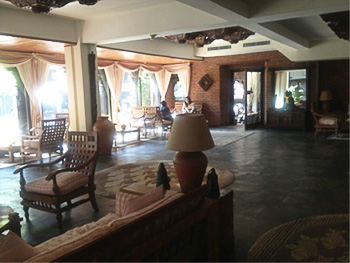
We spent our first two nights at the Dwarika Hotel in Kathmandu, a not-to-be-missed experience. It was conceived of by a Nepalese named Dwarika Das Shrestha, who was concerned that Nepal’s heritage of beautiful wood carvings was going to be forever lost when he saw people destroying old buildings to use the wood for fires.
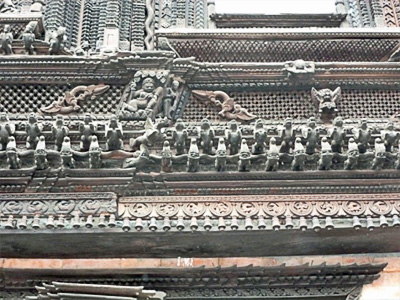
To produce income to enable him to embark on his project, he first added an apartment above his family’s home, using some of the ancient carvings he had saved to frame doors and windows. With the income from the rental he was able to collect more ancient carvings, and soon hired three master carvers who were skilled in the traditions of ancient Newari wood carving. (The Newari were the original tribal people in the Kathmandu Valley) Soon there were apprentices, ensuring that the tradition would continue.
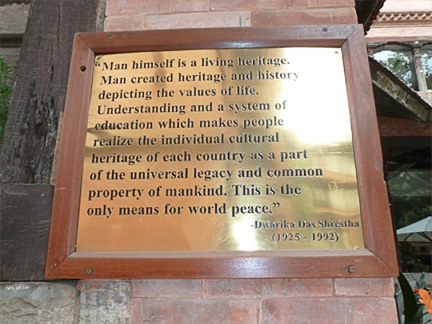
Dwarika continued to build on his property, building after building, all with exquisite wood panels throughout. Within a few years he had a thriving hotel business. Today it is an oasis of calm in the midst of the noise and congestion of Kathmandu. Not only are the surroundings lovely, the service is equally so. There is a pool, a spa, beautiful plantings, fountains, everything to make the Dwarika a haven of serenity.
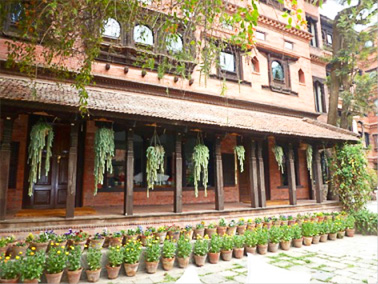
Olga came with her wonderful driver, Ranjan, to take us to her home for dinner on Sunday evening. We were joined by Som, who has replaced Olga as the President of NYF. Som came through the NYF system, having been housed and schooled as a boy at the boys’ boarding school. He qualified for college, and was later awarded a scholarship to study in England where he attained a graduate degree in International Child Welfare. His English is perfect, he is widely traveled, passionate about his work, and having had Olga as his mentor, is extremely capable and effective.
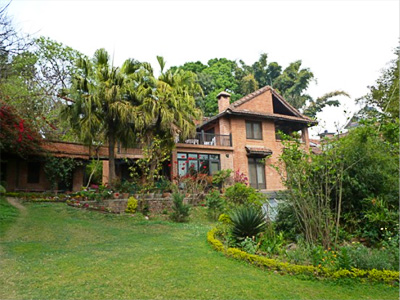
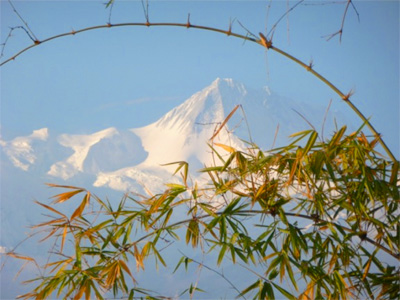
We were taken by a guide for a 2-3 hour hike, through nearby villages the following morning. Poverty is the first word that comes to mind, Many people live in huts with dirt floors. The animals are housed nearby. There are few of the conveniences we take for granted. Women carry heavy loads, leaning forward to balance large baskets which are secured by a strap around their foreheads. Their food is simple, and many of them seldom see any meat. Their daily diet consists of white rice, accompanied by local vegetables which are usually overcooked and served in a curry sauce. They use a lot of herbs and spices in their cooking.
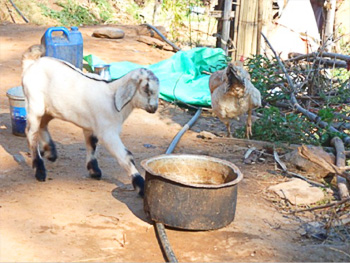
We hiked 10-12 miles the next day, depending on who was describing it. The guide said it would be “flat and undulating.” In fact, it was a lot of uphill, much of it on the roads, followed by extremely steep downhill in the afternoon. We had brought a picnic, and we were joined along the way by a Tibetan with a backpack, who turned out to be selling local trinkets and jewelry. The views were spectacular, across vast, beautifully terraced hillsides. Again, everything said poverty. In spite of which the people seem happy. They have lovely white teeth, they smile a lot. Children in blue uniforms walk up and down hills to get to school. On the roads there are frequent busses, grinding along to get up hill, often crowded to bursting. One rarely sees a car. The roads are in terrible condition, with enormous potholes, often so narrow it seems impossible two vehicles can pass. But they do.

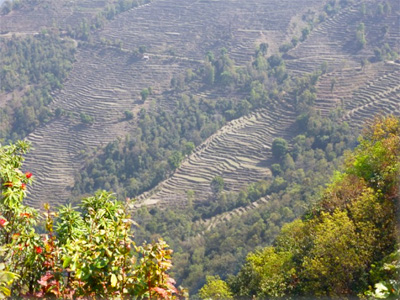
One of the delightful sights was of triplet baby goats! Almost everyone has at least one goat, and it was the season for babies. We also saw a number of small temples, seemingly built in the middle of a field somewhere, who knows how many hundreds of years ago.
From Pohkara we were driven by a handsome young driver, who fortunately was also very skilled, as the driving can be challenging. Our goal was Bandipur, which looked fairly close on the map, but took the better part of the day in the car. We had been advised to go to Bandipur because of the views, impossible to see as the weather was cold and overcast. The village itself looked as though there had been a recent earthquake, there was rubble everywhere. It is a very old village, as was The Olde Inn where we stayed. Very small rooms, low ceilings, and very dark. As they also have power outages, Helen and I were happy to have our flashlights, or as she would say, “torches.”
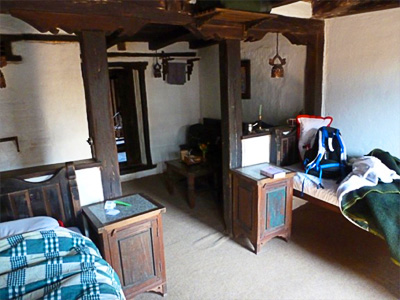
Our room was out of the 19th century. Stepping over a foot high sill, we entered a small bedroom with a balcony on the main street. The balcony looked as though it might collapse if two people stood on it at the same time, so we took turns. There were two small beds, a basin mounted on the wall by one of the beds, and a small alcove containing a toilet and shower. No curtain or anything, the shower drained into the middle of this tiny room, and we didn’t risk it. We just felt lucky that the toilet flushed!
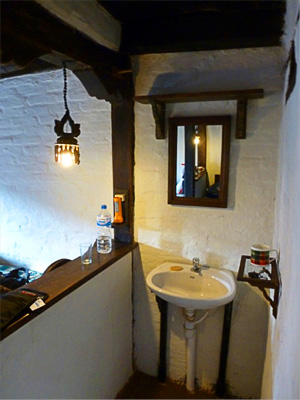
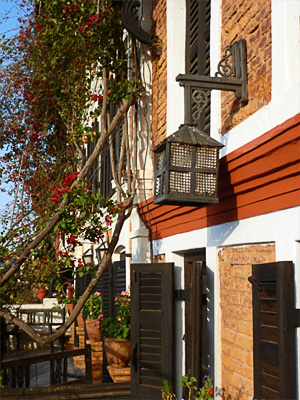
We were served dinner in one of the many small rooms on the main floor, with an elaborate candelabra providing candle light as the power was off. There is not enough power in Nepal, thus every area has rolling blackouts, often for 6-12 hours a day!
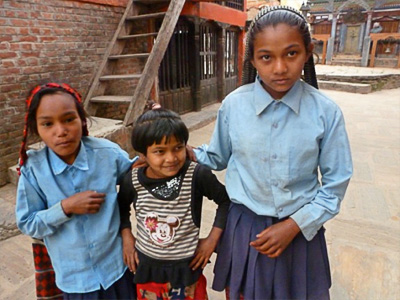
We investigated the village on foot the following morning. More rubble, more trash, parts of the village looked as though they had been abandoned a century ago yet there were people coming and going as though everything was as it should be. The sun peeped through the mist and we enjoyed a pleasant breakfast on the hotel terrace, accompanied by the two hotel dogs.
* * *
On to Kathmandu once again, Sundar at the wheel. It was a long day, became very warm once we were down the mountain. That took quite a long time as the road was clogged with trucks and buses, not to mention the ever-present motorcycles. The pollution was heavier, along with the trash everywhere, the closer we came to Kathmandu. We were happy to arrive at the Hyatt by late afternoon.
The next two days we were joined by Sangita, a local guide. She has two daughters, one studying Public Health at Truman University in Missouri, the other studying medicine in China. Her English was quite good, and her local knowledge was excellent. We visited temple after temple after temple. For me they all began to blend together, and I could not keep the names straight. Most were Hindu, some were Buddhist. In Nepal the Hindus and Buddhists get along without a problem, even worshipping one another’s gods. That makes some sense, given that Buddhism came from Hinduism, but given the dismal record of religions throughout history, it is comforting that the two religions can co-exist without rivalry.
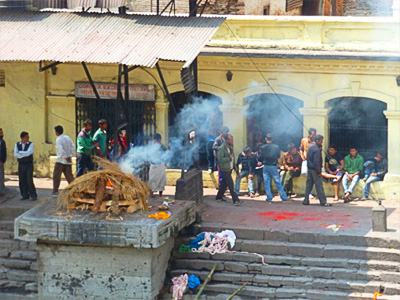
Perhaps the low point of the temple visiting was Pashupatinath, considered one of the holiest shrines of all Hindu temples in the world. It is on a river, and overlooks the cremation grounds next to the river, where the ashes of the deceased are thrown after the cremation. There are a series of temples large and small, cows wandering around haphazardly, people everywhere, trash everywhere, all accompanied by the rather unsettling smell of burning flesh. There were people posing as holy men, lounging on various structures, many of whom appeared to be stoned. Their goal was to be photographed and then insist on being paid. To top it all off there is an enormous souvenir market that one must pass through to get back to the road.
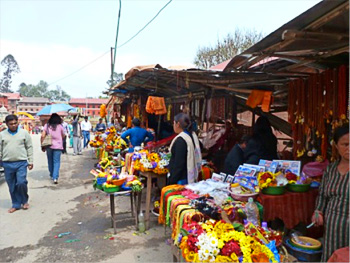
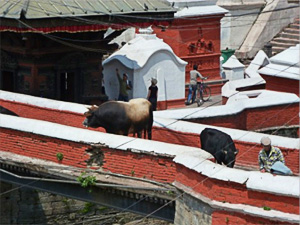
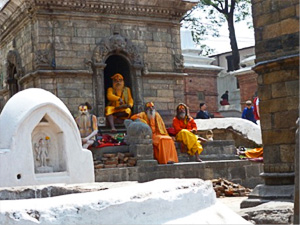
Having been spoiled by Dwarika’s, we managed to move back there for our third evening back in Kathmandu. We had the same wonderful room and were delighted to be able to once again take in all that beauty, serenity, good food and lovely service.
We continued our sightseeing with Sundar and Ranjeeta, our guide. Mostly we saw temples, and temples and temples.
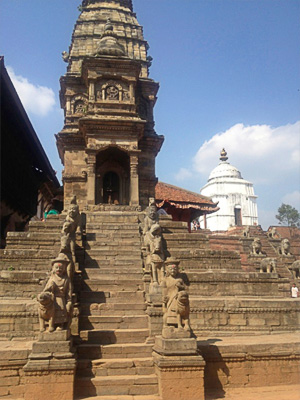
Outside of Kathmandu the traffic was not so bad, and we visited Bhaktapur, and Nagarkote, villages reputed to have interesting temples and great views. Unfortunately the views were invisible because of air Pollution. Nonetheless it was interesting to drive through the countryside.
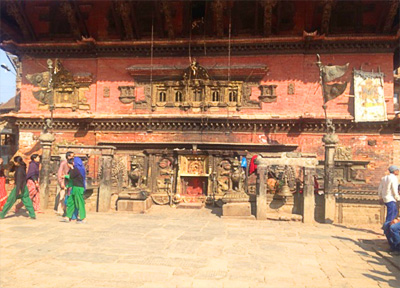
Ranjan arrived to take us to Olga’s in Patan the following morning. Her home is also a haven, a peaceful spot just off a busy, bumpy road under construction. In fact, many of the main roads in Kathmandu are being widened, which is causing more congestion than ever. Their approach to the project is interesting, as they seem to tear down everything in the way of the project, and leaving all the rubble right there. People amble down the street, picking their way over stones, beams, and other remnants of prior construction, seemingly completely accustomed to such hazards, and such dust.
* * *
Our next three days were spent at Olga’s. Her house has a flower garden that is colorful and delightful, there is also an organic vegetable garden from which we ate lovely fresh lettuce and vegetables. Rom does the cooking and serving, he is always cheerful, and devoted to Olga. Our visit turned out to be even better than we had expected. The highlight was our visit to the two boarding schools, one for boys and one for girls. The children range in age from 3-15. At 15 they are placed in other residential facilities, as there is no longer room to house them at the schools.
Olga always said she does this work because she fell in love with the Nepalese children. It is easy to understand, now that we have been there. These children are endearing. They are friendly, polite, curious, and their English is very good once they start school where they are taught in English. The little ones come up and take your hand, they want to show you their room, or where they have their meals, or the play area outside. At one point when I was up on the roof, having had a complete tour of the facility by Mojon, a friendly 14 year old boy who wanted me to see the entire place, I looked down to see Helen on the basketball court tossing that ball right into the hoop while surrounded by an admiring group of children.
Mojon was so interested in us, he and a younger boy who seemed very attached to Mojon asked me question after question about my favorite movie, my favorite football team, my favorite movie star, etc. They were so well-mannered, so friendly, so proud of their living space. When it was mealtime, the older boys helped set the tables, everyone eats from the typical metal plates with sections for the daily white rice, curry, and accompaniments. I was surprised to see that the boys across from us were eating with their fingers, although Sangita, seated next to me, was using a fork. When I asked about it later, I was told that many Nepalese always eat with their fingers.
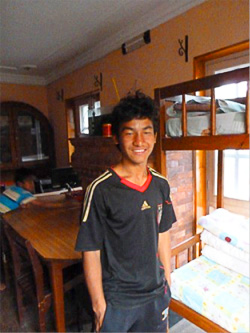
It’s almost impossible to describe the feeling one gets in those schools. The children are all polite, they are quiet, yet they’re enthusiastic. There are few toys of any kind, their routine is about studying and going to school, keeping the place neat and orderly, and being with one another. The older children are very sweet with the younger ones. It feels like one big, loving family, and it is very touching.
Each and every one of these children has a frightful background. One little three year old girl was found with her arms around the body of her dead mother, who had been stabbed over and over again by her husband. Sangita, Liese’s sponsee for years, was found begging on the street as a child. She lived alone with her father, a severely handicapped, beggar, in total squalor. Once he knew Sangita would be cared for he committed suicide. Today she is a lovely, graceful 15 year old young woman, excels in her academics, and has plans to go to college.
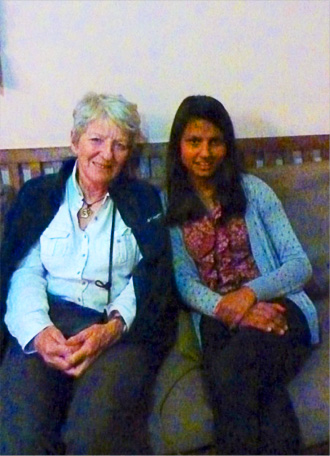
We also visited one of the 16 Nutritional Health Centers that NYF has founded. Malnourished children come to the home with their mother, or sometimes it is their father, for six weeks or sometimes more. The child receives a nutritious diet, the main part of which is a porridge made of two parts wheat, one part soy, and one part corn meal. This seems to be the magic that brings them into robust health so quickly. The parents are taught about nutrition, and how to prepare nutritious food for their families using the vegetables and grains that are locally available. No supplements are used.
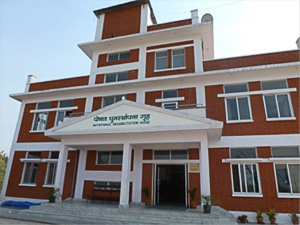
NYF builds the facilities, hires the staff, and then once the program is well-established, the Nepalese government takes over the expense of keeping the facility in operation.
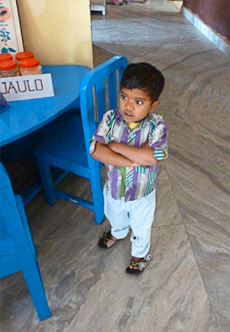
NYF has been very effective in getting government support for their programs, however there is widespread corruption in the country. Everyone is cautiously optimistic there will be improvement after the upcoming election. Thanks to NYF, the government has backed the program to end child bondage, and it is almost non-existent today. However, domestic abuse is an overwhelming problem. Women are killed or severely abused if they don’t produce a son, for instance. No one seems to have told the Nepalese that it is the man who is responsible for the sex of the child.
Less important, perhaps, no one seems to have told the Nepalese that there is such a thing as a trash container.
Trash is so thick. The little food stores carry a lot of our snacks now. I have never seen so many Frit-o-Lay packages in my life! The only good news is that they don’t use plastic bags, thus all this trash is presumably going to decompose at some point — hopefully.
We left Kathmandu feeling we had experienced something special. Life in Nepal is so different from anything we know, much of it is worrisome, but seeing all the good work being done by NYF, the children whose futures have been changed, the smiles on the faces of so many, one feels hope.